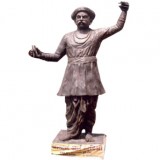SANT EKNATH is one of the great rishis of Maharshtra. Starting from the life of Jnaneshwar (1275-1298), whose treatise on the Bhagavad Gita sprang new life into the religious life of the land, Maharashtra was blessed with a stream of great religious figures, who sustained the faith of the people in the religion of the land through many hardships. The religious renaissance eventually transformed the society completely, culminating in Independence from Islamic rule for most of India.
The life of Eknath acted like a bridge between his predecessors Jnaneshwar and Naamdev and his successors Tukaram and Ramdas His teachings of philosophy and practice is a synthesis of the quest for the eternal and transcendent while living within the imminent. This great saint of Maharashtra was born sometime around 1530 AD in a Brahmin family which had brought forth great teachers in the past. Eknath’s father, Suryanarayan, and mother, Rukmini died shortly after his birth, hence Eknath was brought up by his grandparents, Chakrapani and Saraswatibai. Throughout his childhood Eknath devoted his time significantly to devotional practices.
When about twelve years old, Eknath heard about a man named Janardan Swami. This great scholar lived in Devgiri renamed as Daulatabad by the Muslim rulers of the time. Eager to become his disciple, Eknath trudged all the way to Devgiri. Janardaswamy was amazed by this extra-ordinarily gifted boy and readily accepted him as his disciple. He taught Eknath Vedanta, Nyaya, Meemansa, Yoga etc. (i.e. a broad based education of Hindu dharma) and most importantly, Sant Jnaneshwar’s works.
Janardan Swami was a devotee of Lord Dattatreya, the son of Atrimuni and his wife Anasuya. Eknath soon achieved self-realisation through his dedicated practice. The Guru then asked Eknath to proceed on pilgrimage. He himself accompanied Eknath upto Nasik-Tryambakeshwar. Here, Eknath wrote his famous treatise on Chatushloki Bhagavat. Which was a treatise on the application of four sacred shlokas of the holy “Bhagavat.” Eknath’s work consisted of 1036 specially metered verses known as “ovee”s. After completing his pilgrimage of various holy places of west and north India, Eknath returned to Paithan where he was born. His grandparents were extremely delighted to see him again and implored him to marry. Eknath married a lady named Girija. The couple were truly made for each other and established the ideal examples of ethical living. In time, the couple was blessed with two daughters, Godavari and Ganga and a son Hari.
During the intervening period of about 250 years between Dnyaneshwar and Eknath, various Islamic invaders ravaged Maharashtra. Defeats after defeats had completely demoralised people. The great legacy of Jnaneshwar was nearly forgotten. Eknath devoted himself to change this situation. His first task was to locate the “samadhi” of Jnaneshwar and trace the undistorted version of “Jnaneshwari” (Jnaneshwar’s treatise of the Bhagavad Gita). In fact, without Eknath’s all-out efforts, the legacy of Jnaneshwar could well have been lost to the succeeding generations. He also devoted him self in fighting against untouchability and other ills, which were rotting the society. His inspiration to fight untouchability were the teachings of Sri Krishna. Eknath’s teachings may be summarized as “Vichar, Uchchar and Achar” – i.e., purity of thought, speech and practices. Exemplifying the way of ethical and spiritual living, he practised what he preached. His works, verses and preaching kindled hope among the people at a time when they needed it most. At last following the example of the great Jnaneshwar, he left for his heavenly abode by voluntarily laying down his life in the sacred Godavari on the Krishna Shasthi day of Phalguna in the year Shaka 1521 (1599AD).
(56994)
